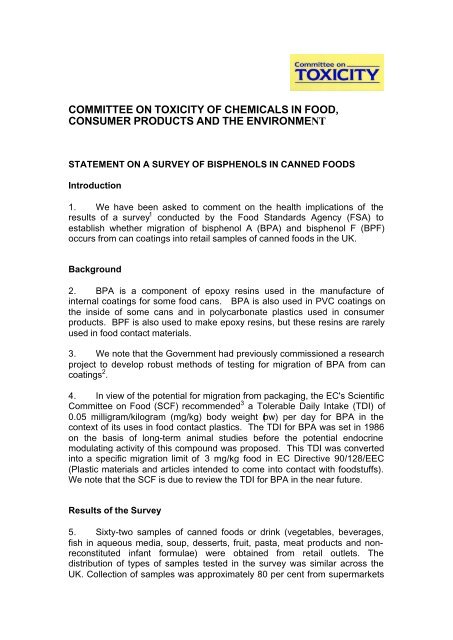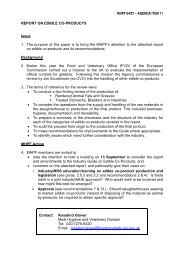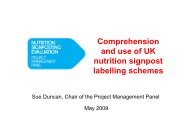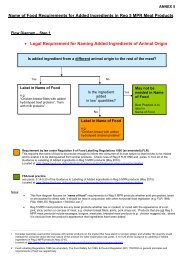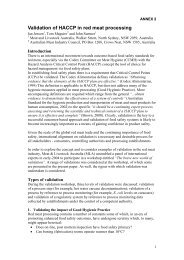COT Bisphenols pdf - Food Standards Agency
COT Bisphenols pdf - Food Standards Agency
COT Bisphenols pdf - Food Standards Agency
You also want an ePaper? Increase the reach of your titles
YUMPU automatically turns print PDFs into web optimized ePapers that Google loves.
COMMITTEE ON TOXICITY OF CHEMICALS IN FOOD,<br />
CONSUMER PRODUCTS AND THE ENVIRONMENT<br />
STATEMENT ON A SURVEY OF BISPHENOLS IN CANNED FOODS<br />
Introduction<br />
1. We have been asked to comment on the health implications of the<br />
results of a survey 1 conducted by the <strong>Food</strong> <strong>Standards</strong> <strong>Agency</strong> (FSA) to<br />
establish whether migration of bisphenol A (BPA) and bisphenol F (BPF)<br />
occurs from can coatings into retail samples of canned foods in the UK.<br />
Background<br />
2. BPA is a component of epoxy resins used in the manufacture of<br />
internal coatings for some food cans. BPA is also used in PVC coatings on<br />
the inside of some cans and in polycarbonate plastics used in consumer<br />
products. BPF is also used to make epoxy resins, but these resins are rarely<br />
used in food contact materials.<br />
3. We note that the Government had previously commissioned a research<br />
project to develop robust methods of testing for migration of BPA from can<br />
coatings 2 .<br />
4. In view of the potential for migration from packaging, the EC's Scientific<br />
Committee on <strong>Food</strong> (SCF) recommended 3 a Tolerable Daily Intake (TDI) of<br />
0.05 milligram/kilogram (mg/kg) body weight (bw) per day for BPA in the<br />
context of its uses in food contact plastics. The TDI for BPA was set in 1986<br />
on the basis of long-term animal studies before the potential endocrine<br />
modulating activity of this compound was proposed. This TDI was converted<br />
into a specific migration limit of 3 mg/kg food in EC Directive 90/128/EEC<br />
(Plastic materials and articles intended to come into contact with foodstuffs).<br />
We note that the SCF is due to review the TDI for BPA in the near future.<br />
Results of the Survey<br />
5. Sixty-two samples of canned foods or drink (vegetables, beverages,<br />
fish in aqueous media, soup, desserts, fruit, pasta, meat products and nonreconstituted<br />
infant formulae) were obtained from retail outlets. The<br />
distribution of types of samples tested in the survey was similar across the<br />
UK. Collection of samples was approximately 80 per cent from supermarkets
and included about 40 per cent 'own brand' foods to approximate consumer<br />
shopping habits. The cans were stored sealed at room temperature and then<br />
the contents were homogenised, solvent-extracted, filtered and analysed by<br />
GC-MS for BPA and BPF. The analytical methodology was of acceptable<br />
sensitivity and precision (limit of detection: 0.002 mg/kg; limit of quantification:<br />
0.007 mg/kg).<br />
6. No BPF was detected in any of the samples. In contrast, BPA was<br />
detected at up to 0.07 mg/kg in 37 samples and at 0.35 to 0.42 mg/kg in three<br />
cans of one sample. BPA was not detected in the four samples of infant<br />
formulae. We note that the BPA content of the contaminated samples was<br />
probably due to migration of residual monomer in the can coating, except for<br />
one sample with a higher level of contamination where BPA was used to<br />
cross-link the coating. We have been informed that the manufacturer has<br />
already replaced the coating system that resulted in the high level of<br />
contamination by a system that is more compliant with minimising potential<br />
BPA migration.<br />
7. We were provided with estimates of BPA intake for adults and infants,<br />
which were based upon the mean contaminant level and high level<br />
consumption of the canned foods in this survey (1.051 kg for adults and 0.375<br />
kg for infants). Intake was estimated at 0.00036 to 0.00038 mg/kg body<br />
bw/day for adults (assuming lower and upper bound mean contaminant levels<br />
of 0.0207 mg/kg and 0.0217 mg/kg respectively for all foods except baby<br />
foods, and a body weight of 60 kg). Intake was estimated at 0.00083 to<br />
0.00087 mg/kg bw/day for infants (assuming lower and upper bound mean<br />
contaminant levels of 0.0194 mg/kg and 0.0204 mg/kg respectively for all<br />
foods and a body weight of 8.8 kg).<br />
Toxicological considerations<br />
8. We are aware that the potential endocrine modulating activity of some<br />
man-made and naturally occurring chemicals, including BPA, continues to be<br />
investigated by many regulatory bodies and research groups world-wide. We<br />
have therefore paid particular attention to this activity in considering the health<br />
implications of intake of BPA from canned foods.<br />
9. In 1997 this Committee considered 4 the health implications of a US<br />
study 5 on low-dose endocrine-modulating effects of BPA which had been<br />
widely quoted in the media. At that time, we did not consider that it would be<br />
justified to draw any conclusions about the health implications of human<br />
exposure to BPA based on these results. We also gave consideration to a<br />
compilation of toxicity studies, some unpublished, put together by the<br />
American Society of Plastics Industry which included reproductive toxicity<br />
(fertility), and developmental studies of BPA. We noted that effects were<br />
demonstrated on reproductive parameters in rats and mice, but only at very<br />
high doses. These were conventional toxicity studies demonstrating a noeffect<br />
level of 50 mg/kg bw/day, a value 25000 times higher than the low dose
eported to increase prostate weight in the study of Nagel and co-workers<br />
mentioned above 5 .<br />
10. We note that an extensive review of BPA is in progress under the<br />
Existing Substances Regulations (ESR) (793/93/EEC). We were presented<br />
with a draft ESR report 6 which provided an up-to-date review of the large body<br />
of toxicological data on BPA, including several recent studies (some<br />
unpublished) designed to investigate the potential for endocrine modulating<br />
activity and other effects on the reproductive system. We considered the draft<br />
ESR report to be a valuable source of information in respect of our<br />
deliberations on BPA.<br />
11. We note that BPA has been shown to have endocrine modulating<br />
activity in a number of in vitro and in vivo screening assays, with a potency<br />
generally ranging from 3 to 5 orders of magnitude less than that of the natural<br />
hormone oestradiol. The data indicate that there is a marked strain<br />
difference in the response to BPA in both rats and mice.<br />
12. In developmental toxicity studies of orthodox regulatory design, using<br />
rats and mice, BPA did not induce structural malformations (including of the<br />
male and female reproductive organs), even at maternally toxic doses of<br />
greater than 500 mg/kg/day 7,8 . In a multigeneration study, reduced fertility<br />
was detected in rats exposed to 500 mg BPA/kg/day, but not at lower doses<br />
(0.001 to 50 mg /kg/day) 9 . Using a continuous breeding protocol, reduced<br />
fertility was also detected in mice exposed to 600 mg BPA/kg/day, and a<br />
decrease in epididymal weight in F1 males was observed at 300 mg/kg/day 10 .<br />
13. In contrast to the effects on rat and mouse fertility that were induced by<br />
exposure to BPA at 500mg/kg/day, effects on the development of<br />
reproductive organs have been reported following BPA exposure at 100,000<br />
to 1000 fold lower doses. Two research groups have reported increases in<br />
prostate weight and in anogenital distance, and a reduction in epididymal<br />
weight in the male offspring of mice exposed to 0.002 to 0.050 mg<br />
BPA/kg/day 5,11,12 . Other researchers, using larger numbers of animals, have<br />
attempted to replicate these studies, but have not observed any effects of<br />
BPA within this dose range 13,14 . It has been suggested that mouse strain<br />
differences might explain this discrepancy, but there are no data to support<br />
this assertion. Precocious vaginal opening has been observed in immature<br />
mice treated with 0.1 mg BPA/kg/day 15 .<br />
14. There is much current debate over the suggestion that some<br />
relationships between dose and toxic response may not follow a conventional<br />
upward trend, that is, there could be U-shaped response curves. The<br />
reported effects of BPA on reproductive organ development have not been<br />
shown to follow such a relationship, but have been termed “low-dose”<br />
because they occur well below the no-effect levels that have been observed in<br />
orthodox toxicity testing.<br />
15. The Committee acknowledges the reports of apparent low-dose effects<br />
of BPA, and is aware that the numerical data from these studies have been
independently validated 16 . The Committee considers that it is not appropriate,<br />
at this time, to base human health risk assessment on these reports, for<br />
several reasons. Firstly, it is not known whether the reported effects are<br />
transient or irreversible. Secondly, the functional significance of the reported<br />
effects is unknown, and this should be seen in the context of functional<br />
studies that observe effects only at very much higher doses of BPA. Thirdly,<br />
the observations of low-dose effects of BPA are not robust, in that they cannot<br />
be independently reproduced in other competent laboratories. Fourthly, other<br />
chemicals that can induce subtle effects on the developing reproductive<br />
organs inevitably cause more gross defects at higher doses, whereas BPA<br />
shows no such gross developmental toxicity.<br />
Conclusions<br />
16. We note that the FSA survey demonstrated that BPA migrates from<br />
can coatings into food at low levels. BPF was not found to migrate at<br />
detectable levels. From the results of this survey the intake of BPA by adults<br />
and infants was in the region of two orders of magnitude below the TDI<br />
established by the SCF in 1986, set before the potential endocrine modulating<br />
activity of this substance was proposed.<br />
17. We note that BPA has shown endocrine-modulating activity in in vitro<br />
and in vivo screens. We acknowledge the reports of apparent low-dose<br />
effects of BPA. However in view of the uncertainty relating to the functional<br />
significance of the effects, as well as the lack of reproducibility, we considered<br />
that it is not appropriate, at this time, to base human health risk assessment<br />
on these reports.<br />
18. The most recent multi-generation studies on BPA demonstrated effects<br />
on fertility in rats at high doses, and support earlier observations of a no<br />
observable adverse effect level (NOAEL) of 50 mg/kg bw/day. We consider<br />
that there is a substantial margin of safety (about 100,000 fold) between<br />
human exposure to BPA via canned food and doses that cause effects on<br />
fertility in animal studies.<br />
19. We acknowledge the uncertainties that exist in the scientific<br />
understanding of potential endocrine effects of BPA. Nevertheless, on<br />
present evidence we conclude that the levels of BPA identified in canned<br />
foods analysed in the FSA survey are unlikely to be of concern to health, and<br />
that there is no reason for consumers to change their source of foodstuffs as<br />
a result of these findings. It would be prudent to review this toxicological<br />
advice as further scientific evidence on possible low-dose effects of endocrine<br />
modulating substances unfolds.<br />
April 2001
REFERENCES<br />
1. <strong>Food</strong> Surveillance Information Sheet No. 13/01<br />
2. Cooper I, Bristow A, Tice PA and O’Brien AP (1997). Methods of analysis<br />
to test for migration from coatings on metal containers. Final report – MAFF<br />
Project FS2217, Pira ref SP94/2, Pira International, Leatherhead, Surrey, UK.<br />
3. Commission of European Communities. Report of the Scientific Committee<br />
for <strong>Food</strong> (1986). 17th Series Report. EUR 10778 EN.<br />
4. Committee on Toxicity of Chemicals in <strong>Food</strong>, Consumer Products and the<br />
Environment, Annual Report 1997, Department of Health.<br />
5. Nagel SC, vom Saal FS, Thayer RA, Dhar MG, Boechler M and Welshons<br />
WV (1997). Relative binding affinity-serum modified access (RBA-SMA) assay<br />
predicts the relative in vivo bioactivity of the xenoestrogens bisphenol A and<br />
octylphenol. Env. Health Perspect. 105:70-76.<br />
6. Draft UK Risk Assessment of 2,2-bis(4-hydroxyphenyl)propane (bisphenol<br />
A): Human Health Effects. Report R325_0102-hh. February 2001.<br />
7. National Toxicology Program (1985). Teratologic evaluation of bisphenol A<br />
(CAS No. 80-05-7) administered to CD-1 mice on gestational days 6 through<br />
15. Report NTP-85-088; Order No. PB85-205102 (NTIS).<br />
8. National Toxicology Program (1985) Teratologic evaluation of bisphenol A<br />
(CAS No. 80-05-7) administered to CD(R) rats on gestational days 6 through<br />
15. Report NTP-85-089, Order No. PB85-205112 (NTIS).<br />
9. Tyl RW, Myers CB and Narr MC (2000). Three generation reproductive<br />
toxicity evaluation of bisphenol A administered in the feed to CD (Sprague<br />
Dawley) rats. Unpublished report-Research Triangle Institute RTI Project<br />
Number: 65C-07036-000.<br />
10. National Toxicology Program (1985). Bisphenol A: Reproductive and<br />
fertility assessment in CD-1 mice when administered in the feed. Report NTP-<br />
85-192; Order No. PB86-103207 (NTIS) 1-346.<br />
11. vom Saal FS, Cooke P, Buchanan DJ, Palanza P, Thayer KA, Nagel SC,<br />
Parmigiani S and Welshons WV (1998). A physiologicaly based approach to<br />
the study of bisphenol A and other oestrogenic chemicals on the size of<br />
reproductive organs, daily sperm production and behaviour. Toxicology and<br />
Industrial Health 14 (1/2) 239-260.<br />
12. Gupta (2000). Reproductive malformation of the male offspring following<br />
maternal exposure to estrogenic chemicals. Proc. Soc. Exp. Biol. Med. 224<br />
(2) 61-68.
13. Cagen, SZ, Waecher JM, Dimond SS, Breslin WJ, Butala JH, Jekat FW,<br />
Joiner RL, Shiotsuka RN, Veenstra GE and Harris LR (1999). Normal<br />
reproductive organ development in CF-1 mice following prenatal exposure to<br />
bisphenol A. Toxicological Sciences, 50 36-44.<br />
14. Ashby J, Tinwell H and Haseman J (1999). Lack of effects for low dose<br />
levels of bisphenol A and diethylstilbestrol on the prostate gland of CF1 mice<br />
exposed in utero. Reg Toxicol and Pharmacol 30 156-166.<br />
15. Markey CM, Michaelson CL, Veson EC, Sonnenschein C and Soto<br />
(2001). The mouse uterotrophic assay: A reevaluation of its validity in<br />
assessing the estrogenicity of bisphenol A. Environmental Health<br />
Perspectives 109 (1) 55-60.<br />
16. Endocrine Disrupters Peer Review Draft Reports (2001) - Statistics and<br />
Dose-Response Modelling Sub-panel:<br />
http://ntp-server.niehs.nih.gov/htdocs/liason/LowDoseDraftStatRpt.<strong>pdf</strong>).


